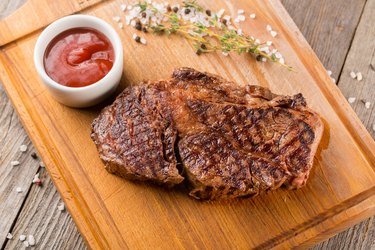
Chuck roast steak is much like an ordinary cut of steak, albeit a little tougher. Chuck comes from the shoulder region of the animal, one of the hardest-working muscular areas. Learn how to cut a chuck roast into a steak and properly cook it.
What Is a Chuck Cut?
Video of the Day
According to the USDA Food Safety and Inspection Service (USDA FSIS), there are four main cuts of beef: loin, rib, round and chuck. Beef bought in the supermarket will have a label indicating the cut as well as the product, such as "round steak." This way, consumers can figure out how long and which method to use to cook the meat. A chuck cut is usually less tender and requires a moist heating method, such as braising.
Video of the Day
But what is a chuck roast exactly and why is it a tougher meat? According to the U.S. Meat Export Federation, chuck meat comes from the forequarter of the animal, where there are many hardworking muscles. It's a tasty, yet tough meat, as the thicker the muscle, the chewier the meat will be.
The University of Nebraska–Lincoln Institute of Agriculture and Natural Resources recommends ways of cooking beef, depending on the cut. A chuck blade roast, for example, would need to be roasted or braised, whereas a chuck blade steak could be braised, grilled or broiled. You'll likely want to tenderize the meat beforehand with a marinade, such as our delicious Fresh Mango Marinade, to break down the muscle fibers and collagen.
Read more: 5 Healthy Red Meat Recipes That Satisfy
Chuck Roast Steak: How To
Chuck steak, or boneless top chuck steak, is also known as book steak, butler steak and flat iron steak, among other names, says the Cattleman's Beef Board and National Cattleman's Beef Association. While some beef chuck steak recipes are oven bound, others can be pan fried on the stove. A University of Richmond recipe explains how to cut and prepare a flat iron steak from a top blade chuck roast:
- To cut flat iron steaks from a top blade roast, cut along the thick internal connective tissue that runs through the middle of the roast. Removing this tissue will divide the roast into two halves, which will look similar to small flank steaks.
- Next, place the steak in a resealable bag with a chuck steak marinade made from olive oil, minced garlic, wine, salt, pepper, mustard powder and fresh, chopped rosemary, parsley and chives.
- Let the steak marinate in the refrigerator for two to three hours.
- Heat a nonstick pan on medium-high heat.
- Place the steak in the pan and fry for three to four minutes. Flip to the other side and repeat.
- For a medium-rare steak, cook until the internal temperature reaches 145 degrees Fahrenheit; let the steak rest for five minutes before serving.
Plate the steak alongside our Simple Steamed Brussels Sprouts, which require minimal preparation and provide only 127 calories per 1-cup serving. For another complementary side dish, try this LIVESTRONG.com recipe for Maple Glazed Sweet Potato Steak Frites With Pecans.
Read more: What Is the Healthiest Meat?
Steak-Handling Safety Tips
As is always the case when handling and cooking meat, it's important to follow the proper food safety guidelines. According to the USDA FSIS, beef roasts and steaks should be cooked to an internal temperature of no less than 145 F according to a food thermometer.
In terms of storage, steaks and roasts can be kept in the refrigerator for up to five days and in the freezer for up to 12 months. Purchase beef before its expiration date, keep it in its package until you're ready to use it and follow the handling instructions on the package.
Because cutting chuck into steaks requires touching raw meat, wash your hands with soap and water after handling. You'll also want to store packages of meat in disposable plastic bags to prevent leakage in the refrigerator. When defrosting, do not leave meat out on the counter at room temperature. Thaw it in the refrigerator, microwave or under cold water.
- USDA Food Safety and Inspection Service: "Beef From Farm to Table"
- University of Nebraska–Lincoln Institute of Agriculture and Natural Resources: "Beef Meat Identification"
- U.S. Meat Export Federation: "Chuck Family"
- University of Richmond: "Bistro Beef Tender"
- Cattlemen's Beef Board and National Cattlemen's Beef Association: "Flat Iron Steak"